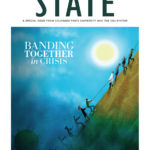By Coleman Cornelius | Photo by John Eisele / Colorado State University
In her first address to campus, President Joyce McConnell urged Colorado State University students, faculty, and staff to embrace “courageous strategic transformation” – to move well beyond the predictability of strategic planning and to instead commit to bold, high-impact action.
“It signals actual change,” McConnell said of her concept, during the President’s Fall Address to a crowd of hundreds on the historic campus Oval in September. “It speaks to the unexpected, to the extraordinary, even the impossible. That’s what we’re aiming for at CSU.”
Her charge came shortly after McConnell stepped into the top leadership role at Colorado State, becoming the land-grant university’s 15th president during its 150th anniversary year. She was officially invested with the role during an academic ceremony on Nov. 14, after being hired last spring by the Board of Governors of the Colorado State University System. McConnell is the university’s first female president. She succeeds Tony Frank, who now serves as full-time chancellor of the CSU System, which includes Colorado State in Fort Collins, CSU Global, and CSU-Pueblo.
McConnell’s call for informed and nimble change encompassed all aspects of the System’s flagship university: academic curriculum, research and scholarly activity, administrative processes, and the campus climate for people with diverse backgrounds and viewpoints. “Courageous strategic transformation means moving forward with our minds and our hearts wide open to new ideas, to new ways of doing what we need to do,” she said. “It means including all who must be included and accounted for in our community and in our world.”
In outlining her vision, McConnell echoed both the optimism and the urgency that have underpinned Colorado State University since its founding in February 1870. Funded in part with grants of public land, the university was established to ready students from working-class families for professional success and improved quality of life; their college educations, based on scientific and classical studies, prepared students to devise critically needed solutions in agriculture, engineering, and many other economically vital fields. Those tenets endure today, even as the university and the scope of its work have grown dramatically, the new president noted in her first major campus address earlier this fall.
In her initial months, McConnell has often underscored the land-grant principle of providing talented students from all backgrounds with access to excellent education. The concept is central to a range of contemporary issues, from college affordability to campus incidents of racism and bias, which have erupted at Colorado State and other campuses across the state and nation.
After two such incidents at the start of the fall semester, McConnell announced the launch of a CSU Race, Bias, and Equity Initiative aimed at prioritizing the safety and supporting the success of students with diverse backgrounds and perspectives.
“As a land-grant institution founded on the principle of access, we cannot turn our backs on any of our students,” she said, while announcing the initiative during the President’s Fall Address. “We owe it to all our students to create an environment in which they can flourish and succeed.”
Here, too, McConnell urged a commitment to courageous strategic transformation as the basis for problem-solving: “We will set the standard across the nation and the world for what a great land-grant university looks like in the 21st century. Colorado State has a proud history of 150 years of work on behalf of the people of Colorado and of the world. Let’s join to up our game!” she exhorted the crowd.
McConnell has honed her knowledge of the land-grant mission during a career in higher education. Trained as a lawyer, McConnell grew up near Washington, D.C., and worked for 23 years at West Virginia University; like Colorado State, WVU is a land-grant school that has grown into a top-tier public research university. McConnell started there as a law professor, became a widely respected dean of the WVU law school, and then served as provost and vice president for academic affairs, the No. 2 campus leader.
At CSU, McConnell has a big task: The university is riding a wave of momentum, with remarkable gains in enrollment, graduation rates, research and scholarly activity, fundraising, and campus construction. It has a $1.2 billion annual budget, student enrollment approaching 35,000, total faculty and staff of 7,600, a fundraising campaign that has surpassed $1 billion, and statewide Extension offices serving every county in Colorado.
In the early weeks of her presidency, McConnell sat down with STATE magazine to discuss her new job.
STATE: We talked about some of the metrics that describe the scope of operations at Colorado State. What attracted you to the position of president here?
McConnell: Well, those data points are very similar to WVU. In my job as provost there, I was both internally and externally facing, and that gave me a lot of insight into the complexity of a university this size, what it means to be a state’s land-grant, and all the responsibility that comes with it. There were also certain aspects of Colorado State that really spoke to me. It is a historic land-grant, and it is classified as a Carnegie Research 1 university, so it takes its research very seriously. And it is very authentic in its messaging about the importance of access and success for all students. CSU is also really future-focused in its work on sustainability. All of those factors are very important to me. Looking at it as a whole, it just seemed like the most perfect fit I could have imagined.
STATE: You are the first woman to become president at CSU. To put that in perspective, the American Council on Education reports that 30 percent of U.S. college presidents are women. What does it mean to you personally, and what do you think it means for students, university employees, alumni, donors, and other stakeholders?
McConnell: I don’t think I initially understood the impact of being the first woman president at CSU. My focus was on being the best president I could be. Then I realized being the first woman has its own significance. Everyone around me was telling me, “This is amazing. There aren’t that many women presidents of large universities.” But the moment it really clicked for me is when my 33-year-old daughter called, and her friends were with her. She said, “My mom just became the president of Colorado State University,” and I could hear these wonderful women just yelling and screaming and saying, “That’s incredible!” That was the moment when I went, “Oh, this really has meaning.” It’s not just for me, not just for my family, but for women who are looking at, “What can I do in my life? What is possible?” This delivered a message that it is possible.
STATE: How do you think your role as CSU’s first female president relates to our land-grant mission in access to education?
McConnell: I believe the strength of pioneering women was really reflected in the fact that Colorado State, as a land-grant, was open to women from the very beginning. That speaks volumes about the independent spirit in Colorado. I think access is so important because if a student has what it takes to succeed at this university, they need to be here. They need to be here because this excellent education will not only transform their life, it will transform their family’s lives for generations to come. President Lincoln signed the Morrill Act in 1862 and created land-grant universities so that higher education would be available to all people; it wouldn’t be just wealthy people, who could afford private universities, and that remains a mission today. Think about the power of that. It’s awe-inspiring.
STATE: What other aspects of our land-grant roots and mission remain especially important 150 years later?
McConnell: The language in the Morrill Act of 1862 refers to colleges established to teach agriculture, the mechanical arts, and other scientific and classical studies that help people develop practical solutions to problems. I think the greatest legacy for land grants – 150 years later for Colorado State – is that same focus on, “How do we solve the world’s problems?” We’ve seen an evolution in what it means to take education, research, and service to improve the lives of people who live in Colorado, the United States, and the world, yet that land-grant mission of local discovery with global impact is something that has really lasted, and we see it every day on campus.
The connection of CSU to the state of Colorado also remains very important. I truly believe the return on investment for state funds used in educating students returns over and over and over again, even with something as straightforward as expanded tax base from the higher earnings of college-educated students. Given Colorado’s trend toward more high-tech industry – including high-tech needs in agriculture, for crop production, protein production, and animal care – we have a huge responsibility to Colorado and its economy to make sure we are meeting needs in research and workforce education.
STATE: You touched on investment in higher education, which raises the topic of tuition costs. This academic year, tuition remains unchanged for undergraduates who are Colorado residents. But over the past couple decades, CSU and other land-grant universities have faced decreasing funding from states. How do you communicate the problems to families faced with rising tuition, if not from year to year, then over time?
McConnell: I am grateful to the governor and state Legislature for support that allows us to hold tuition flat for resident undergraduates this year. When I’ve talked to alumni, they didn’t always know tuition was inexpensive when they went to school because the majority of university funding came from the state, which kept tuition low. Over time, declining state support has shifted the tuition burden onto students and their families. For a Colorado resident graduating from CSU, the average debt is about $25,000. What I share with parents is, that’s the price of a car, and it’s reasonable indebtedness for graduates just starting out. There are ways to go to college and for it to be affordable. In the end, studies show that every person who has an undergraduate degree as opposed to a high-school degree is going to earn, on average, a million dollars more over a lifetime. That’s a good investment.





